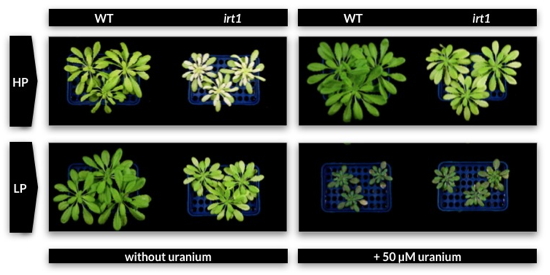Uranium is naturally present in the environment. It can be redistributed by mining, military and agricultural activities. This radionuclide, which is chemotoxic for all living organisms, can accumulate locally at concentrations that present potential risks for agrosystems and human health. Indeed, even though it is not essential for plants, uranium is absorbed from the soil, incorporated into the biomass and thus enters the food chain. Understanding the physiological, biochemical and molecular mechanisms that control the response and adaptation of plants to uranium-induced stress is a prerequisite for selecting species suitable for phytoremediation and improving food safety.
Researchers at our institute analyzed the effects of uranium in a mutant of
Arabidopsis thaliana (irt1 mutant) that is affected in the absorption of iron, an essential element whose homeostasis is strongly impacted by uranium.
The high affinity iron transport by the IRT1 protein is not a major uranium uptake pathway in Arabidopsis since the
irt1 mutant (in which the IRT1 protein is inactive) accumulates as much radionuclide in its roots and leaves as a wild type plant. However, analysis of the
irt1 mutant response to uranium stress reveals several levels of interference between the radionuclide, iron and phosphate. Thus, when the availability of phosphate in the medium is sufficient, the
irt1 mutant suffers from iron deficiency in chloroplasts. These symptoms (chlorosis, inhibition of photosynthesis) are abolished by uranium in the
irt1 mutant as well as in wild type plants, which are healthier than in the absence of the radionuclide. This unexpected beneficial effect of uranium is due to a competition between the radionuclide and iron for complexation with phosphate. In roots and leaves, uranium might be able to displace inactive iron from iron-phosphate complexes to release active iron for biogenesis processes and metabolism. When phosphate is a limiting factor in the medium, the bioavailability of uranium is increased and the radionuclide is absorbed more efficiently by the plant. The toxic effects of uranium are then clearly visible in the wild plant and
irt1 mutant (oxidative stress, growth arrest). Metabolic analyses show that one of the key mechanisms of uranium toxicity is related to the interference with phosphate homeostasis and more particularly to the induction of a deficiency in phosphorylated compounds.
This work highlights that iron and phosphate homeostasis are intimately linked, and that any disturbance affecting one of the two elements has repercussions on many cellular processes. The study suggests that uranium could divert the molecular machinery for iron import, translocation, complexation and sequestration.

Yin-yang effects of uranium on the physiology of the wild plant Arabidopsis thaliana (WT) and mutant irt1. After 4 to 5 weeks of hydroponic culture under standard conditions, Arabidopsis WT and irt1 plants are treated with uranyl nitrate, in the presence of high phosphate (HP) or low phosphate (LP) concentrations. Observations after a 21-day exposure in the presence of 50 μM uranyl nitrate.